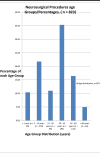Duration of In-hospital Stay for Elective Neurosurgical Procedures in a Tertiary Care Hospital
- PMID: 34285851
- PMCID: PMC8286779
- DOI: 10.7759/cureus.15745
Duration of In-hospital Stay for Elective Neurosurgical Procedures in a Tertiary Care Hospital
Abstract
Objective: Public hospitals have fixed days with allotted time slots during which to perform neurosurgical elective cases. If emergency operations or other events preempt these scheduled time slots, the patient remains hospitalized, waiting in queue for a new time slot. We conducted this study to determine the number of days patients remained admitted waiting for elective cases in a tertiary care public hospital, which operates on fixed days.
Materials and methods: This cross-sectional study was conducted in the Department of Neurosurgery Unit B, Medical Teaching Institution (MTI) - Lady Reading Hospital (LRH), Peshawar. We reviewed the admission charts and discharge slips of all patients who were admitted and underwent operations between September 2018 and August 2019. A form was made and was completed with each patients' records like age, gender, number of days spent preoperatively and postoperatively and the total duration of stay, indication for surgery (spinal, cranial, peripheral nerve), etc. Patients who had undergone elective neurosurgical procedures were included while those who had undergone emergency surgeries or had expired during the hospital stay, had been discharged or referred to other centers were excluded from the study. All the data were entered into the statistical software SPSS version 22 (IBM Corp., Armonk, NY) and were converted into tables and charts.
Results: A total of 1818 patients were admitted/discharged during the study period, and of them, 823 patients were admitted for elective neurosurgical procedures. There were 601 (73.7%) males and 222 (26.3%) females with a male to female ratio of approximately 3:1. The age range was from 09 days to 72 years and was further subdivided into six groups. The procedures were broadly divided into cranial, spinal, related to hydrocephalus (HCP)-related, and miscellaneous. Cranial procedures comprised of surgeries for brain tumors, transsphenoidal operations, vascular procedures for aneurysms, and nerve decompressions, and they comprised about 29.43% (n=244) while spinal procedures accounted for 317 (36.63%) procedures, the rest were related to HCP and miscellaneous. Preoperative and postoperative stay durations were calculated and then added to determine the total stay durations and were further stratified for the specific procedures and categorized into days and weeks. About 58.26% (n=143) of cranial cases, and 156 (49.36%) of spinal cases, 37.57% (n=65) of HCP-related cases, and 36.66% (n=41) of cases in the miscellaneous group had a duration of stay between eight days to more than three weeks.
Keywords: duration; elective; in-hospital stay; neurosurgical procedures; tertiary.
Copyright © 2021, Khan et al.
Conflict of interest statement
The authors have declared that no competing interests exist.
Figures




References
-
- Poverty and access to health care in developing countries. Peters DH, Garg A, Bloom G, Walker DG, Brieger WR, Rahman MH. Ann N Y Acad Sci. 2008;1136:161–171. - PubMed
-
- Waiting too long: reducing and better managing. [Jun;2021 ];https://www.doctorsofbc.ca/sites/default/files/waiting_too_long.pdf 2006 Wait:2006–2082.
-
- Length of stay has minimal impact on the cost of hospital admission. Taheri PA, Butz DA, Greenfield LJ. J Am Coll Surg. 2000;191:123–130. - PubMed
-
- Relationship between severity, costs and claims of hospitalized patients using the Severity of Illness Index. Asenjo MA, Baré L, Bayas JM, Prat A, Lledó R, Grau J, Salleras L. Eur J Epidemiol. 1994;10:625–632. - PubMed
LinkOut - more resources
Full Text Sources
Miscellaneous
